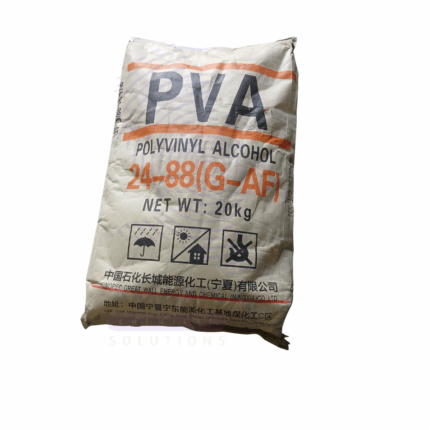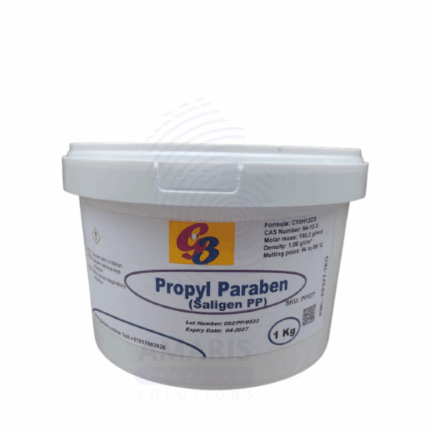Polyethylene Glycol (PEG 6000)
Polyethylene Glycol 6000 (PEG 6000) is a high-molecular-weight polymer derived from ethylene oxide. It appears as a white, waxy solid or flake and is non-toxic, water-soluble, and chemically stable. PEG 6000 is widely used in pharmaceuticals, cosmetics, food processing, industrial formulations, and biotechnology, valued for its lubricating, solubilizing, binding, and moisturizing properties. It is odorless and tasteless, making it suitable for sensitive formulations.
lsions and improves product consistency.
Food Industry
Used as a processing aid, carrier, or anti-caking agent in food additives.
May be found in confectionery coatings, chewing gums, and bakery items.
Recognized as safe (GRAS) for indirect food contact applications.
Industrial Applications
Employed as a mold release agent and lubricant in plastic and rubber processing.
Used as an anti-static and anti-dust agent in powder formulations.
Functions as a dispersant and lubricant in textile and leather finishing.
Biotechnology & Laboratory Use
Commonly used for protein precipitation and DNA purification.
Acts as a crowding agent in cell fusion and virus precipitation.
Serves as a medium for enzyme storage and protein stabilization.
Secondary Uses
Paints and Coatings
Used to improve flow, leveling, and flexibility in water-based paints and coatings.
Printing Inks & Toners
Functions as a binder and viscosity regulator for better print quality and stability.
Ceramics and Construction
Acts as a binder and plasticizer in ceramic slurries and dry mix mortars.
Improves workability and water retention.
Agricultural Chemicals
Used as a carrier and wetting agent in pesticide and fertilizer formulations.
Adhesives and Sealants
Improves flexibility and tack in hot-melt adhesives and sealant compositions.
Basic Identification Attributes
Chemical Name (IUPAC): Poly(oxy-1,2-ethanediyl), α-hydro-ω-hydroxy-
Common/Trade Name: PEG 6000
CAS Number: 25322-68-3
HS Code: 3907.20.00 (Polyethylene glycol and derivatives)
Synonyms: Polyethylene oxide; Macrogol 6000
Physical & Chemical Properties
Physical State: Solid (flakes or powder)
Color & Odor: White; odorless
Solubility: Completely soluble in water and alcohol
Melting Point: 55–63°C
Molecular Weight: Approx. 6,000 g/mol
Viscosity (25°C, 20% solution): 90–130 cP
pH (5% solution): 4.5–7.5
Safety & Hazard Attributes
GHS Classification: Not classified as hazardous
Toxicity: Non-toxic; safe for topical, oral, and parenteral use
Allergen Status: Hypoallergenic
Inhalation: Low risk; avoid excessive dust exposure
Storage & Handling Attributes
Storage Conditions: Store in a dry, cool, well-ventilated area away from moisture and heat
Container Type: Typically supplied in 25kg kraft paper bags or fiber drums with liners
Shelf Life: Up to 3 years under proper storage conditions
Handling Precautions: Use gloves and dust mask during bulk handling; avoid contact with eyes
Regulatory & Compliance Attributes
Complies with:
USP/NF, Ph. Eur., JP (pharmaceutical grades)
FDA (GRAS for food contact and excipient use)
REACH and RoHS (industrial use)
ISO 9001 certified production
Environmental & Health Impact
Biodegradability: Biodegradable under aerobic conditions
Ecotoxicity: Low ecological risk
Bioaccumulation: Not expected
Allergenic Potential: None
Safety Handling Precautions
PPE Required: Gloves, safety glasses, dust mask (bulk use)
Handling Guidelines:
Minimize dust generation
Avoid ingestion or eye contact
Use in well-ventilated areas
Storage Measures: Keep sealed in moisture-proof containers
First Aid Measures
Inhalation: Move to fresh air; seek help if coughing or discomfort persists
Skin Contact: Wash with water and mild soap
Eye Contact: Rinse cautiously with water for 15 minutes
Ingestion: Rinse mouth with water; generally non-toxic, but consult a physician if large amounts are ingested
Firefighting Measures
Fire Hazards: Slightly combustible at high temperatures
Flash Point: >200°C
Extinguishing Media: Water spray, CO₂, dry chemical, or foam
Special Precautions: Avoid dust cloud formation
Hazardous Combustion Products: Carbon dioxide, carbon monoxide


 Preservatives(food)
Preservatives(food) Flavor Enhancers
Flavor Enhancers Acidulants
Acidulants Sweeteners
Sweeteners Antioxidants
Antioxidants Colorants(food)
Colorants(food) Nutraceutical Ingredients (food)
Nutraceutical Ingredients (food) Nutrient Supplements
Nutrient Supplements Emulsifiers
Emulsifiers
 Collectors
Collectors Dust Suppressants
Dust Suppressants Explosives and Blasting Agents
Explosives and Blasting Agents Flocculants and Coagulants
Flocculants and Coagulants Frothers
Frothers Leaching Agents
Leaching Agents pH Modifiers
pH Modifiers Precious Metal Extraction Agents
Precious Metal Extraction Agents
 Antioxidants(plastic)
Antioxidants(plastic) Colorants (Pigments, Dyes)
Colorants (Pigments, Dyes) Fillers and Reinforcements
Fillers and Reinforcements Flame Retardants
Flame Retardants Monomers
Monomers Plasticizers
Plasticizers Polymerization Initiators
Polymerization Initiators Stabilizers (UV, Heat)
Stabilizers (UV, Heat)
 Antifoaming Agents
Antifoaming Agents Chelating Agents
Chelating Agents Coagulants and Flocculants
Coagulants and Flocculants Corrosion Inhibitors
Corrosion Inhibitors Disinfectants and Biocides
Disinfectants and Biocides Oxidizing Agents
Oxidizing Agents pH Adjusters
pH Adjusters Scale Inhibitors( water)
Scale Inhibitors( water)
 Antioxidants(cosmetic)
Antioxidants(cosmetic) Emollients
Emollients Fragrances and Essential Oils
Fragrances and Essential Oils Humectants
Humectants Preservatives
Preservatives Surfactants(cosmetic)
Surfactants(cosmetic) Thickeners
Thickeners UV Filters
UV Filters
 Fertilizers
Fertilizers Soil Conditioners
Soil Conditioners Plant Growth Regulators
Plant Growth Regulators Animal Feed Additives
Animal Feed Additives Biostimulants
Biostimulants Pesticides (Herbicides, Insecticides, Fungicides)
Pesticides (Herbicides, Insecticides, Fungicides)
 Active Pharmaceutical Ingredients (APIs)
Active Pharmaceutical Ingredients (APIs) Excipients
Excipients Solvents(pharmaceutical)
Solvents(pharmaceutical) Antibiotics
Antibiotics Antiseptics and Disinfectants
Antiseptics and Disinfectants Vaccine Adjuvants
Vaccine Adjuvants Nutraceutical Ingredients (pharmaceutical)
Nutraceutical Ingredients (pharmaceutical) Analgesics & Antipyretics
Analgesics & Antipyretics
 Analytical Reagents
Analytical Reagents Solvents(lab)
Solvents(lab) Chromatography Chemicals
Chromatography Chemicals Spectroscopy Reagents
Spectroscopy Reagents microbiology-and-cell-culture-reagents
microbiology-and-cell-culture-reagents Molecular Biology Reagents
Molecular Biology Reagents Biochemical Reagents
Biochemical Reagents Inorganic and Organic Standards
Inorganic and Organic Standards Laboratory Safety Chemicals
Laboratory Safety Chemicals Specialty Laboratory Chemicals(Special Laboratory Equipment)
Specialty Laboratory Chemicals(Special Laboratory Equipment)
 Demulsifiers
Demulsifiers Hydraulic Fracturing Fluids
Hydraulic Fracturing Fluids Scale Inhibitors(oil)
Scale Inhibitors(oil) Surfactants(oil)
Surfactants(oil) Drilling Fluids
Drilling Fluids
 Dyes and Pigments
Dyes and Pigments Bleaching Agents
Bleaching Agents Softening Agents
Softening Agents Finishing Agents
Finishing Agents Antistatic Agents
Antistatic Agents
 Admixtures
Admixtures Waterproofing Agents
Waterproofing Agents Sealants and Adhesives
Sealants and Adhesives Curing Compounds
Curing Compounds Concrete Repair Chemicals
Concrete Repair Chemicals Anti-Corrosion Coatings
Anti-Corrosion Coatings
 Surfactants(cleaning)
Surfactants(cleaning) Builders
Builders Enzymes
Enzymes Solvents (Cleaning)
Solvents (Cleaning) Fragrances
Fragrances
 Electronic Chemicals
Electronic Chemicals Catalysts
Catalysts Lubricants
Lubricants Photographic Chemicals
Photographic Chemicals Refrigerants
Refrigerants Automotive chemicals
Automotive chemicals Pyrotechnic Chemicals
Pyrotechnic Chemicals
 Biodegradable Surfactants
Biodegradable Surfactants Bio-based Solvents
Bio-based Solvents Renewable Polymers
Renewable Polymers Carbon Capture Chemicals
Carbon Capture Chemicals Wastewater Treatment Chemicals
Wastewater Treatment Chemicals
 Pigments
Pigments Solvents(paint)
Solvents(paint) Specialty Coatings
Specialty Coatings Binders/Resins
Binders/Resins Additives
Additives Driers
Driers Anti-Corrosion Agents
Anti-Corrosion Agents Functional Coatings
Functional Coatings Application-Specific Coatings
Application-Specific Coatings
 Fresh Herbs
Fresh Herbs Ground Spices
Ground Spices Whole Spices
Whole Spices Spice Blends
Spice Blends Dried Herbs
Dried Herbs
 Leavening Agents
Leavening Agents Dough Conditioners
Dough Conditioners Flour Treatments
Flour Treatments Fat Replacers
Fat Replacers Decoratives
Decoratives Preservatives(baking)
Preservatives(baking)
 Plasticizers & Softeners
Plasticizers & Softeners Reinforcing Agents
Reinforcing Agents Adhesion Promoters
Adhesion Promoters Vulcanizing Agents
Vulcanizing Agents Antidegradants
Antidegradants Blowing Agents
Blowing Agents Fillers & Extenders
Fillers & Extenders Accelerators & Retarders
Accelerators & Retarders























